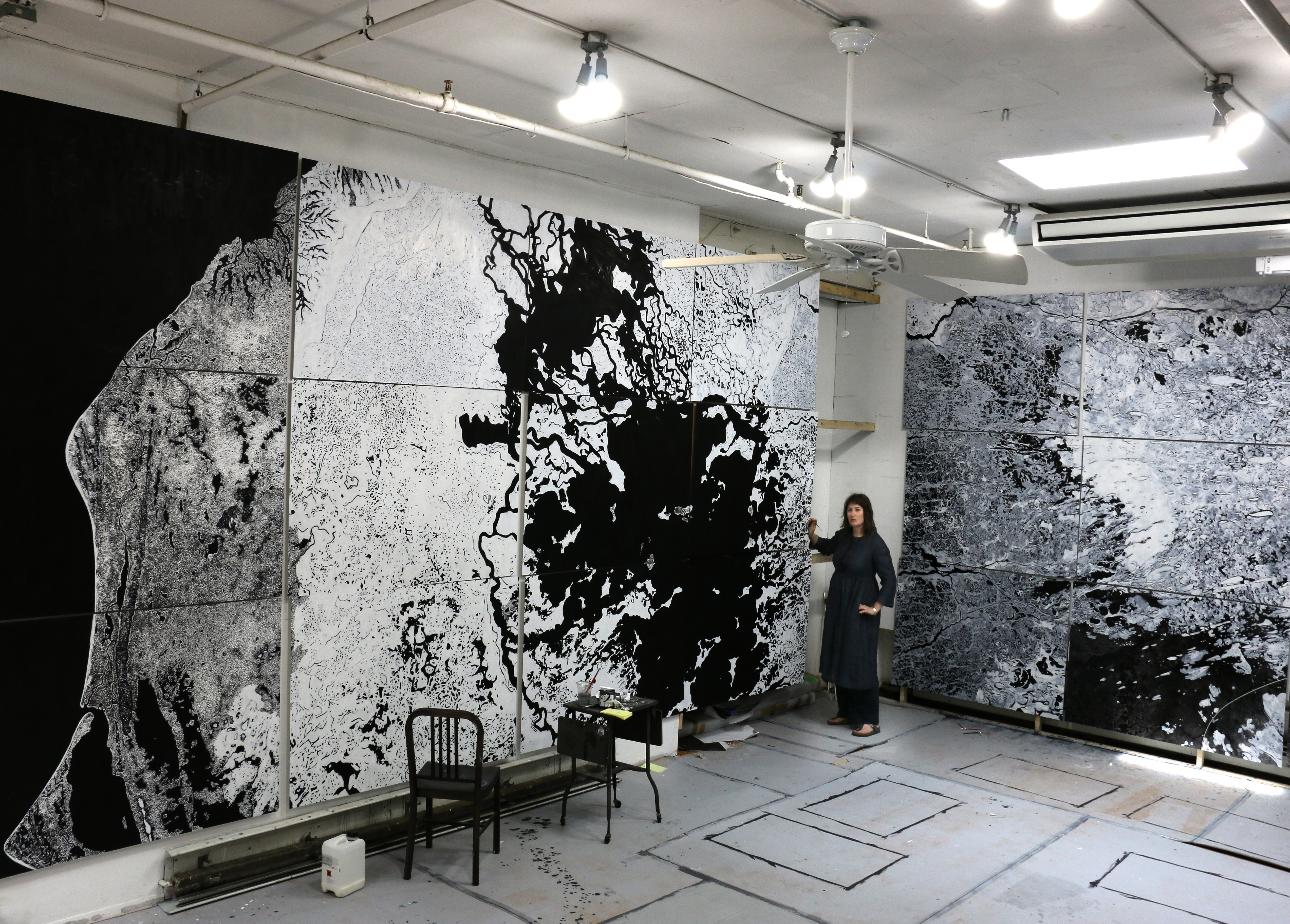
Ellen Harvey’s initial foray into public art was a series of illegal acts. From 1998 to 2001, early in her career, she secretly painted bucolic, decidedly retro landscapes set in elegant ovals on dumpsters, buildings, girders and other spots in New York City. Part of the mystery of the work, known as The New York Beautification Project, was how unlikely a graffiti artist Harvey was. Born in England, she had graduated from Harvard and received a law degree from Yale before entering the Whitney Independent Studies Program. Since then she’s gone legit, showing in numerous museums and galleries, and yet she’s never given up on public art.
Standing in her modest, Williamsburg, Brooklyn studio, where an enormous black-and-white satellite view of Miami Beach and the Everglades blankets the walls, she explains that her ambitions were always broader than the narrow economy of those who can afford to buy her work. Public art allows her to produce something that many people will interact with, and it provides the challenge of more direct communication. “People are seeing it in the midst of lots of competing stimuli,” she says, “and they’re not there primarily to look at your artwork, if at all, so it has to really grab their attention.”

Which brings us to the eye-popping satellite image. It will form the basis of Atlantis, a massive piece commissioned for the renovated Miami Beach Convention Center. Visitors to what was the
Pre-function Room (now renamed the Atlantis Room) will encounter a design, based on the satellite view, sandblasted onto 240 panels of blown glass laminated to industrial mirror. At approximately 1,000 square feet, it will shimmer like the sea.
The conception for the piece occurred to Harvey during a trip to the Everglades a few years back. “I was really struck by this disconnect between natural Florida and man-made Florida,” she says. “And I’d always thought the thing that makes Miami Beach special is this relationship between the urban environment and the water.” Atlantis, which Harvey considers “a love-letter to the Everglades,” manifests this relationship by dividing neatly in half, at precisely the spot where the natural contours of the national park end and human intervention begins. It will appear as a conjunction of two abstract styles, the urban grid of Miami Beach, “a quasi-machine for people,” in Harvey’s words, and the “massively romantic,” swooping, swampy lines of “what nature built.”
It is what humans, and women more specifically, build that her other public-art project celebrates. Scheduled to be installed in South Station, Boston later in 2018, Network will honor the 50th anniversary of the Women’s Transportation Seminar, a group of female engineers. It will take the form of a glass-mosaic map layering the various transport systems of Boston: the harbor, roads, railroads and subways. And, she adds, “because I’m a shameless romantic, there might be a mermaid. There has to be a girlie moment!”

Water seems to run through many of Harvey’s recent efforts. In October, Danese Corey Gallery in New York will show, for the first time in the U.S., Arcadia (2011), a work commissioned for the opening of the Turner Contemporary in Margate, U.K. The work consists of 34 rear-illuminated Plexiglass mirrors, hand engraved with images of the seaside town of Margate, a bustling resort in the 19th century that has long fallen on hard times. As Harvey points out, “Margate is one of the districts that voted for Brexit, and the piece is about the boom and bust cycle, and nostalgia for lost Victorian greatness.” That it might have a political resonance during the Trump years is not lost on the artist.
For all her interest in the simple, direct statements required by public art, what makes Harvey’s public work so incisive is, I think, what she leaves unstated. We can’t go back to the past. The city will redraw a preciously gorgeous landscape, unless we do something to stop it. She allows these notions to form freely in the public mind without ever insisting on them. In a sense, she’s never abandoned the stealthy ways of her early years.



